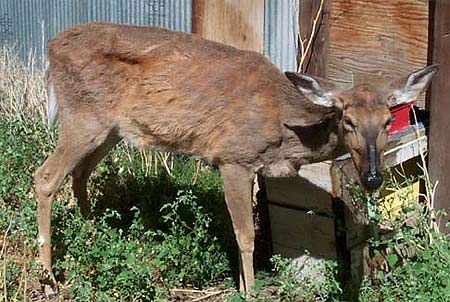WVDNR Reports Chronic Wasting Disease Expanding In WV Deer
W. V. DNR Reports Results from Spring 2010 CWD Surveillance Efforts In Hampshire County; CWD Containment Area Expanded.


HAMPSHIRE COUNTY, W.Va. –-(Ammoland.com)- With the cooperation of local landowners, the West Virginia Division of Natural Resources (DNR) tested 152 deer collected from within one to two miles of previously known locations of Chronic Wasting Disease (CWD) infected deer.
Testing detected the CWD agent in a total of 12 white-tailed deer sampled during the 2010 spring collections in Hampshire County, according to the DNR.
The detection of 15 CWD positive deer during the fall 2009 hunting season, combined with this spring’s testing results, has required the expansion of the CWD Containment Area to include all of Hampshire County.
Within the CWD Containment Area, supplemental feeding and baiting of deer is prohibited and there are transport restrictions for deer carcasses leaving the county.
The spring CWD monitoring of deer provides an incidence rate of infected CWD deer in the area of established infection and removes CWD positive deer from the landscape. In addition, wildlife biologists also use the information to monitor changes in age structure and reproduction in the deer herd within the established CWD infected area.
The first case of CWD in West Virginia was confirmed on September 2, 2005. Since that time, the DNR has been fully engaged in activities guided by its CWD Incident Response Plan, which is designed to accomplish the following objectives:
- Determine the distribution and prevalence of CWD through enhanced surveillance efforts.
- Communicate and coordinate with the public and other appropriate agencies on issues relating to CWD and the steps being taken to respond to this disease.
- Initiate appropriate management actions necessary to control the spread of this disease and prevent further introduction of the disease.
To date, CWD surveillance efforts conducted by the DNR have resulted in a total of 74 deer being confirmed positive for CWD in Hampshire County. Ongoing and extensive surveillance efforts being conducted by Wildlife Resources Section personnel throughout West Virginia has not detected CWD outside of Hampshire County.
CWD is a neurological disease found in deer and elk and belongs to a family of diseases known as transmissible spongiform encephalopathies. The disease is currently accepted as being caused by abnormal, proteinaceous particles called prions that slowly attack the brain of infected deer and elk. Animals progressively become emaciated, display abnormal behavior and invariably die as a result of the disease. There is no known treatment for CWD and it is fatal for the infected deer or elk. It is important to note that currently, there is no evidence to suggest CWD poses a risk for humans or domestic animals.
“Landowner and hunter cooperation throughout this entire CWD response effort in Hampshire County continues to be excellent,” noted DNR Director Frank Jezioro.
“As we strive to meet this wildlife disease challenge and implement appropriate management strategies, the support and involvement of landowners and hunters remains essential. The DNR is committed to keeping the public informed and involved in these wildlife disease management actions.”
